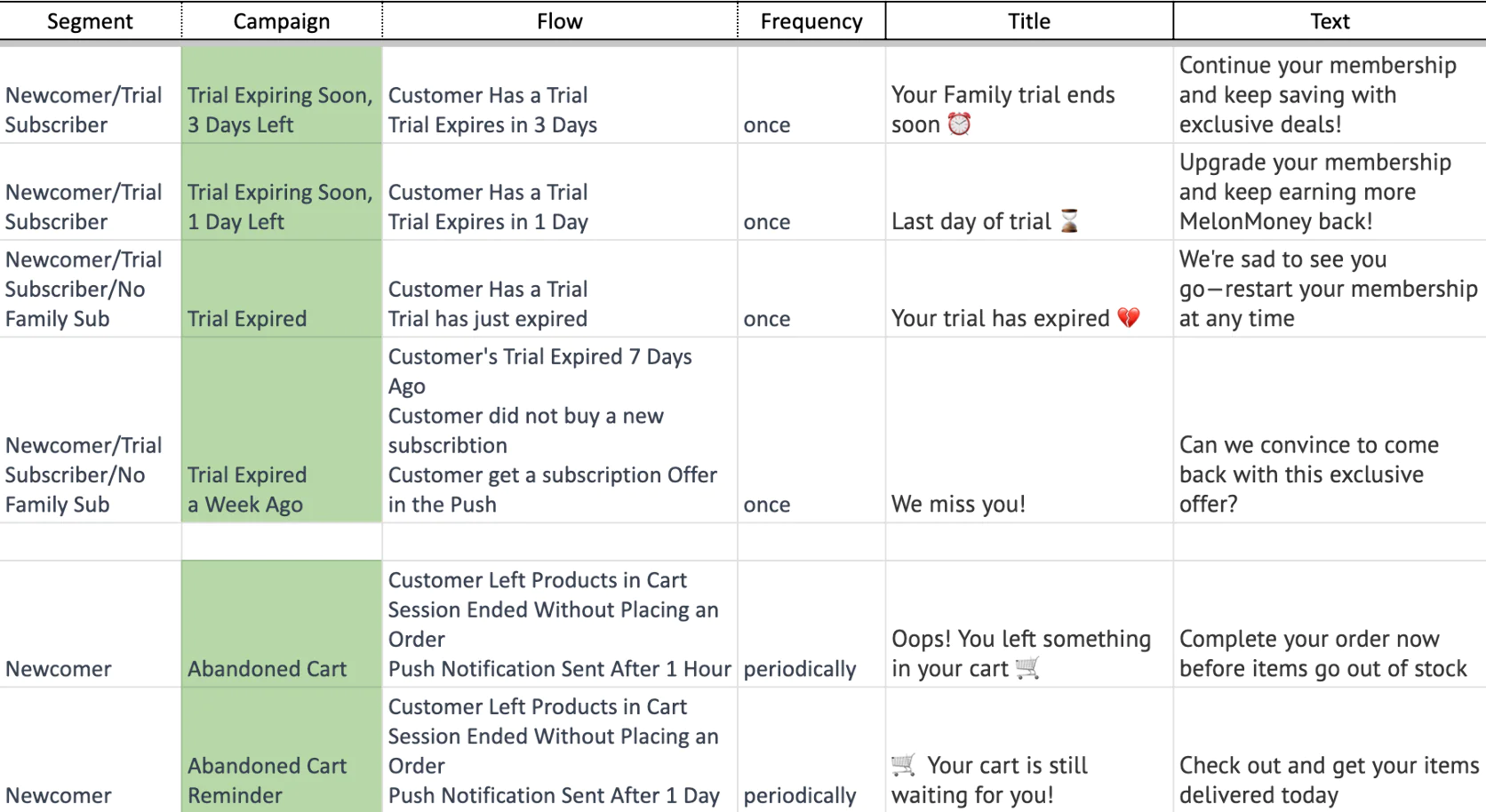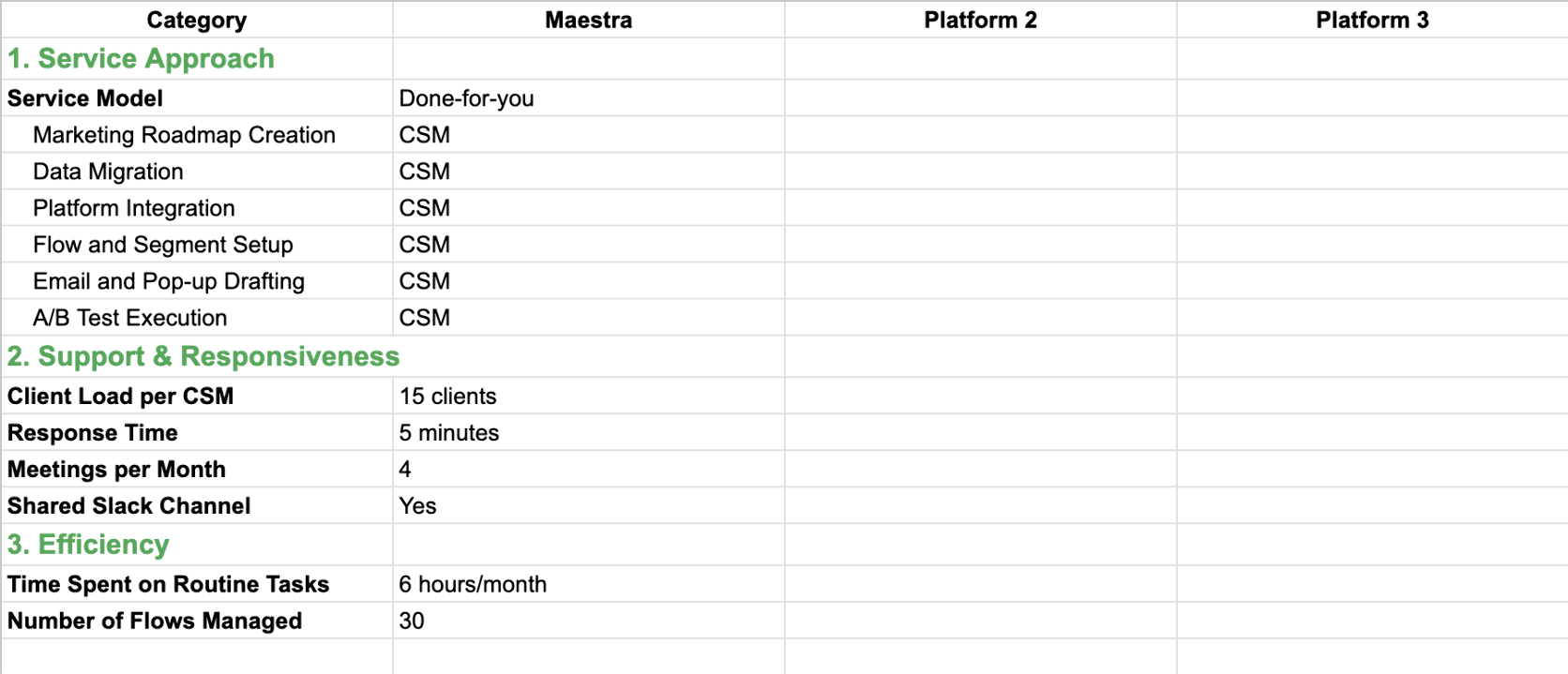Expert guide to choosing marketing automation software with real case studies from TUMI and Furniture Fair. Includes 6-step evaluation framework and total cost analysis.
February 21, 2025
The Complete Guide to Selecting Marketing Automation Software
Question
We’re shopping for a new marketing automation platform and I’ve already sat through like 10 demos. They all sound the same. How do I actually figure out which platform is right for us?
Answer
When evaluating a marketing automation platform, focus on these six key criteria:
- Experience with similar goals: Look for vendors with proven success in your industry, backed by case studies and references.
- Ability to implement key flows: Prioritize platforms that can efficiently support your specific marketing flows.
- Total cost of ownership: Account for all expenses, including hidden costs beyond the subscription fee.
- Customer service quality: Assess the level of support during the sales process—it’s a strong indicator of post-sale experience.
- Reliability and support: Check platform stability, SLAs, and support processes for business-critical operations.
- Development roadmap: Make sure the vendor’s future plans and innovations align with your long-term needs.
Step 1. Experience with Similar Goals
Start a vendor selection process by setting clear business objectives. Using SMART criteria—specific, measurable goals with defined timelines—makes it easier to track results.
Dubious Goal
SMART Goal
Improve customer loyalty
Increase purchase frequency from X to Y purchases per month by December 2025
Work more effectively with new audiences
Increase first-visit-to-purchase conversion from X% to Y% by September 2025
To assess vendors' ability to deliver results, focus on these key areas:
- Ask vendors to demonstrate their understanding of your industry-specific challenges and business objectives.
- Request relevant solutions and potential growth opportunities, backed by real examples.
- Evaluate their experience with projects of similar scale and complexity.
- Review documented case studies that show measurable results.
- Examine 1-3 relevant use cases where they successfully achieved similar objectives
We needed a platform that could segment audiences based on both in-store and online behavior. It had to connect these segments to our marketing channels and personalize recommendations using unified shopping data.
Our crucial metrics included:
• Average Order Value (AOV)
• Number of Orders Over Time
• Most Popular Products
• Trending Products
• Conversion Rates
• Email Open Rates
• Email & Text Engagements
• Customer Lifetime Value (CLV) to measure long-term revenue potential from different customer segments
• Attribution Modeling to assess the impact of specific marketing touchpoints on conversions
Step 2. Ability to Implement Key Flows
Define the marketing campaigns that align with your business goals and list at least five high-impact flows you want to implement. Choose a mix of flows across different channels and audiences to ensure a thorough platform evaluation.
Some vendors offer campaign audits and suggest improvements. At Maestra, the sales team recommends flows after the initial call, and the Customer Success Manager provides detailed flow maps for approval. Speaking with multiple vendors can help refine your approach with their expertise.

Pinemelon grocery delivery mobile push campaigns proposed by Maestra’s Customer Success Manager
To assess vendor’s ability to support your key flows:
- Request live demonstrations of the specific flows you want to implement
- Ask for estimates on implementation time and required resources
- Verify their claims with reference customers
Before switching to Maestra, we conducted an in-depth review process. During live demos, we focused on:
• Ease of use within the campaign builder
• Opportunities to improve product recommendations through enhanced personalization
• Data unification to ensure seamless integration of in-store and online data
The platform’s team asked the right questions to understand our technical and marketing needs. They demonstrated how their system could replace multiple tools we were using, ultimately streamlining our workflow and reducing costs.
When evaluating flows, look beyond the setup interface. Take a close look at data integration capabilities, cross-channel coordination, and the depth of analytics and reporting features.
We walked vendors through our actual use cases and observed how their tools handled tasks like segmentation, email building, and reporting. While every vendor claimed similar features, seeing them in action revealed major differences in usability (UI/UX). Since our team would be working with the platform daily, it was critical to see the real-time demos.
It is essential to involve all key stakeholders in the demo.
For our evaluation process, we involved:
• Me, Digital Marketing Manager (overseeing digital marketing strategy)
• Marketing Director
• IT/Software Engineer (ensuring technical compatibility and integrations)
This mix of expertise allowed us to assess both marketing and technical requirements effectively.
Step 3. Total Cost of Ownership
To make an informed decision about a marketing platform, you need to calculate its return on investment (ROI). Accurately forecasting ROI requires understanding the total cost of ownership, which means looking beyond subscription fees. Both direct and indirect costs should be factored in.
Direct Costs
Indirect Costs
Platform subscription
Internal IT resources
Integration development (some vendors, like Maestra, handle this in-house, reducing costs)
Marketing team time
Channel costs (email, SMS, push notifications)
Professional services (consulting or agency support)
I compared the cost of Maestra against my previous platform and the multiple third-party tools we relied on to fill feature gaps. Before switching, I was using separate platforms for:
• Advanced pop-ups
• Lead generation quizzes
• Product recommendations
• Integrations across marketing channels
By consolidating these functions into a single platform, we reduced costs while improving efficiency and performance.
We requested an itemized pricing breakdown, as some vendors bundle features into the total price, sometimes including hidden costs or services we didn’t need.
We also wanted to understand how different vendors structured their pricing for each feature. Some charged separately for integrations and annual IP fees, while others had varying pricing models for AI features—either as standalone costs or bundled into expensive add-ons.
This gave us flexibility to choose what we actually needed while understanding the cost impact over a three-year contract.
Step 4. Customer Service Quality
Customer service quality can have a bigger impact on project success than technical capabilities. Key areas to evaluate:
- Service model
- Support team availability
- Escalation procedures
- Account management structure
- Training and enablement resources
To help compare vendors effectively, we've developed a comprehensive framework that covers these critical service aspects:

Service Level Comparison Table: Copy our template to evaluate and compare vendors' service models. We’ve pre-filled Maestra’s white-glove service data as a benchmark
Evaluate service quality during the sales process—it’s often a strong indicator post-sale support. Pay attention to
- The sales team preparations for demos, proposed customer success plan
- Response time and follow-up consistency
- Ability to handle technical discussions
The way they manage these steps reflects how well their internal processes are organized.
One of the most critical evaluation criteria was what we called “overall fit and comfort level.” This measured our experience with the vendor throughout the entire process—the sales team, demos, communication, and overall engagement. If a vendor failed to deliver in these areas, it signaled potential challenges in post-contract support.
After all, if they can’t put their best foot forward during the selection process, how can we expect strong service one, three, or even five years into the contract?
Step 5. Reliability and Support
Assess the platform’s reliability and the vendor’s ability to support mission-critical marketing operations.
Key Questions to Ask
- What happens if the platform goes down?
- How are issues escalated and resolved?
- What redundancy measures are in place?
- How is data backed up and secured?
- What are the disaster recovery procedures?
Red Flag
Must-Have
No published SLAs
99.9%+ uptime guarantee
Limited support hours
24/7 emergency support
Undefined issue resolution
Clear escalation process
No monitoring tools
Regular performance reports
Step 6. Development Roadmap
Understanding a vendors’ development roadmap helps ensure long-term alignment with your business needs.
A roadmap isn’t just a list of upcoming features—it reflects the vendor’s product vision, investment in innovation, and update frequency. Just as important is how they incorporate customer feedback and plan to expand integrations. This determines whether they’ll evolve with your business or leave you struggling with outdated technology.
Key Questions to Ask
- How are customer requirements prioritized?
- What major features are planned?
- How frequently are updates released?
- How are breaking changes handled?
- What emerging technologies are being explored?
Making the Decision
Use a weighted scoring system based on these criteria to objectively compare vendors. Assign different weights to each factor in advance to determine which ones will be the most decisive in your choice.
Criterion
Weight
Evaluation Points
Experience
25%
Industry expertise, proven results
Implementation
25%
Workflow capability, integration
TCO
20%
All costs over 3 years
Service
15%
Support quality, responsiveness
Reliability
10%
Platform stability, security
Roadmap
5%
Future development plans
You can adapt this list of criteria to suit your business or create your own.
Here are the criteria that I used to evaluate the ESPs:
• Journey Building Tools (Welcome, Nurture, Cross-shopper)
• Behavioral Messaging (Abandon Cart/Browse, Product Stock Status, Post-purchase)
• Segmentation/Personalization (Custom Audience, Banners)
• Data Integration/Application (Tech Advancements/Limitations)
• Reporting & Results Measurement (Campaigns/Opt-ins/List Growth)
• User Interface—Ease of Use & Time (Campaign Management, Imagery)
• Service & Support (Support Levels/Tiers)
The best platform isn’t necessarily the one with the most features or the biggest market share. It’s the one that best fits your specific needs, has proven success with similar businesses, and is committed to customer success.
Once I confirmed that Maestra met our needs and allowed us to consolidate multiple tools without sacrificing features, the decision was easy. One key question I asked myself was: “What can I accomplish with a team of two dedicated Customer Success Managers who are invested in our success and actively working within the platform?” The answer? A lot more than I could with a fragmented system and limited vendor support.



